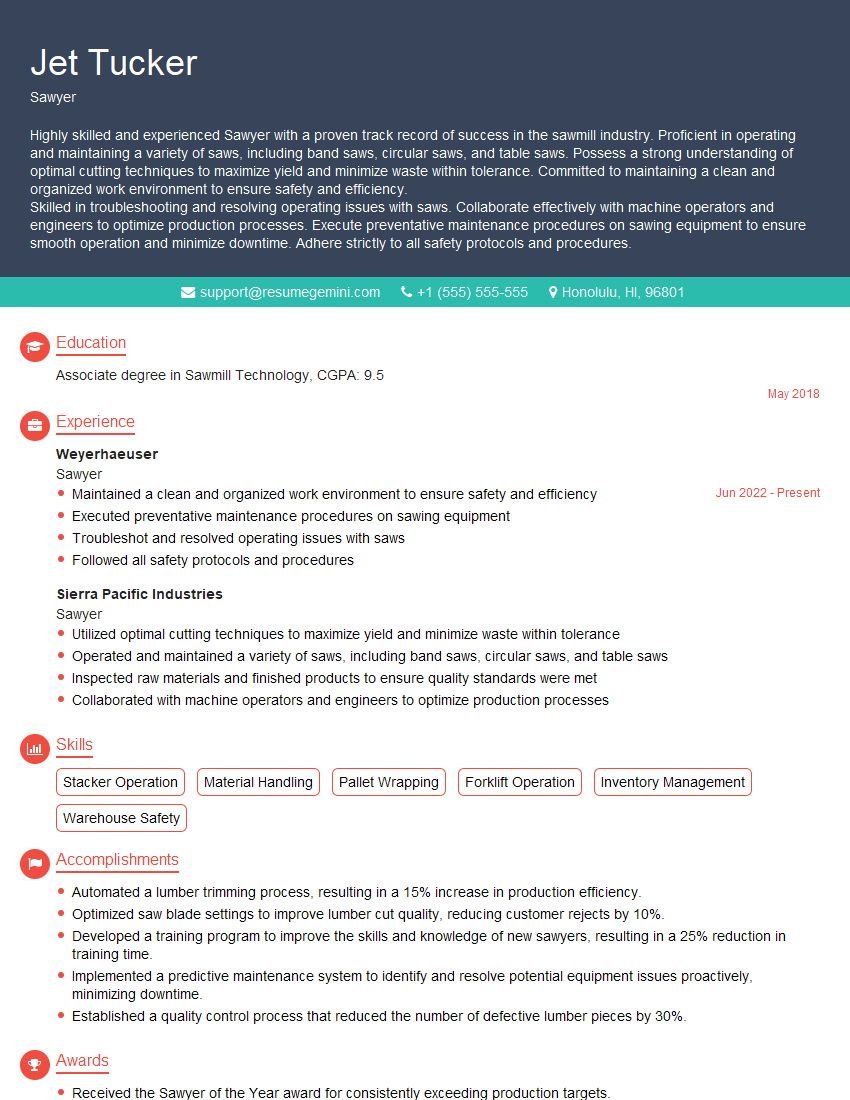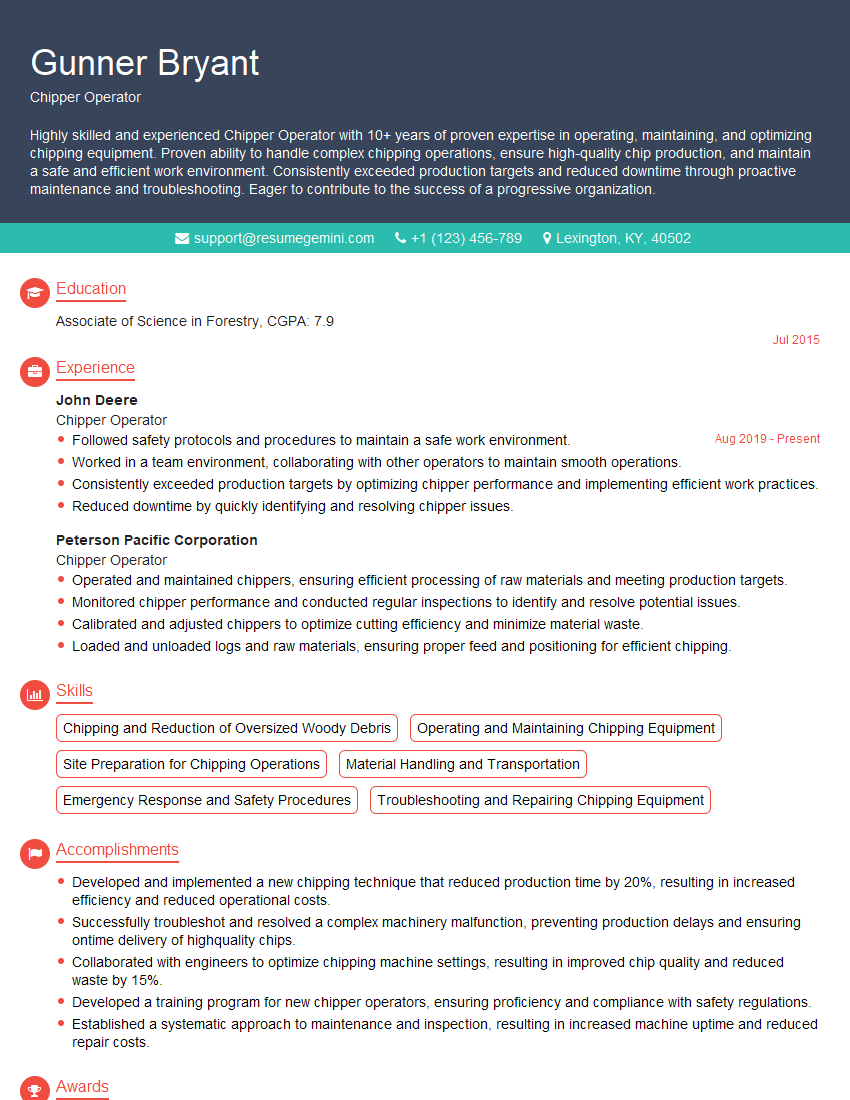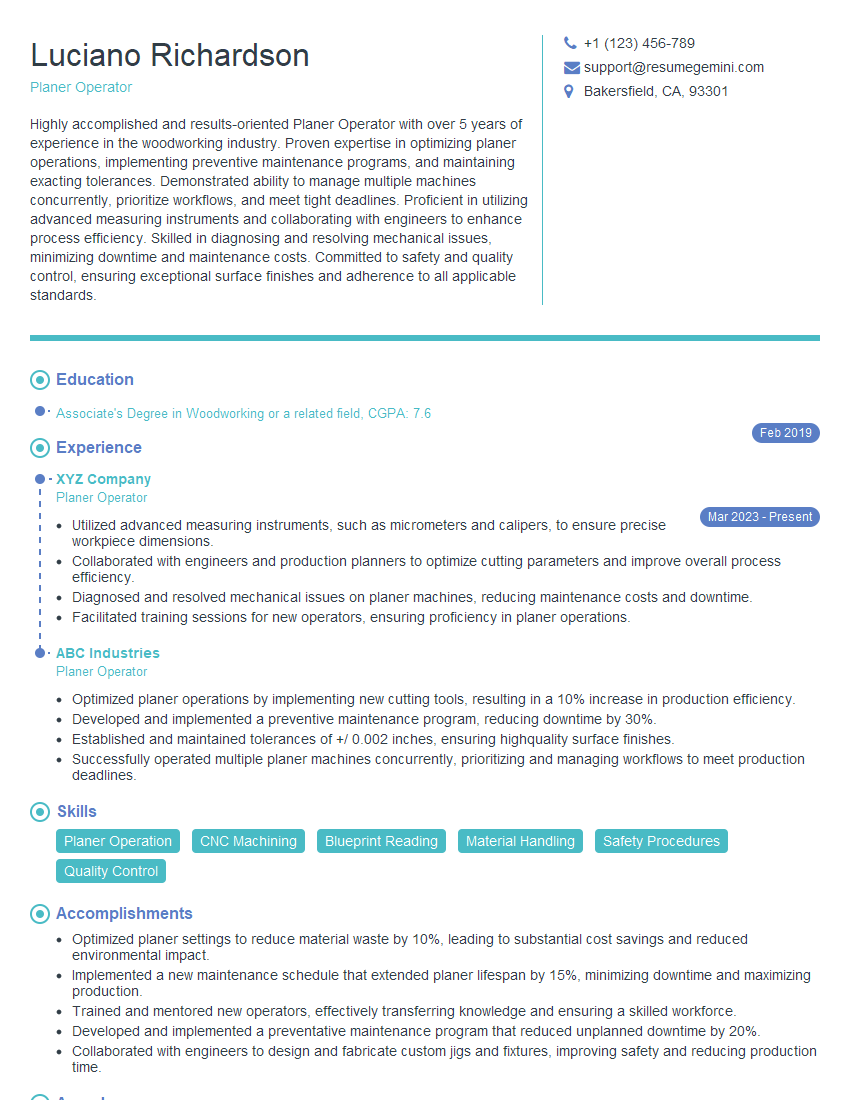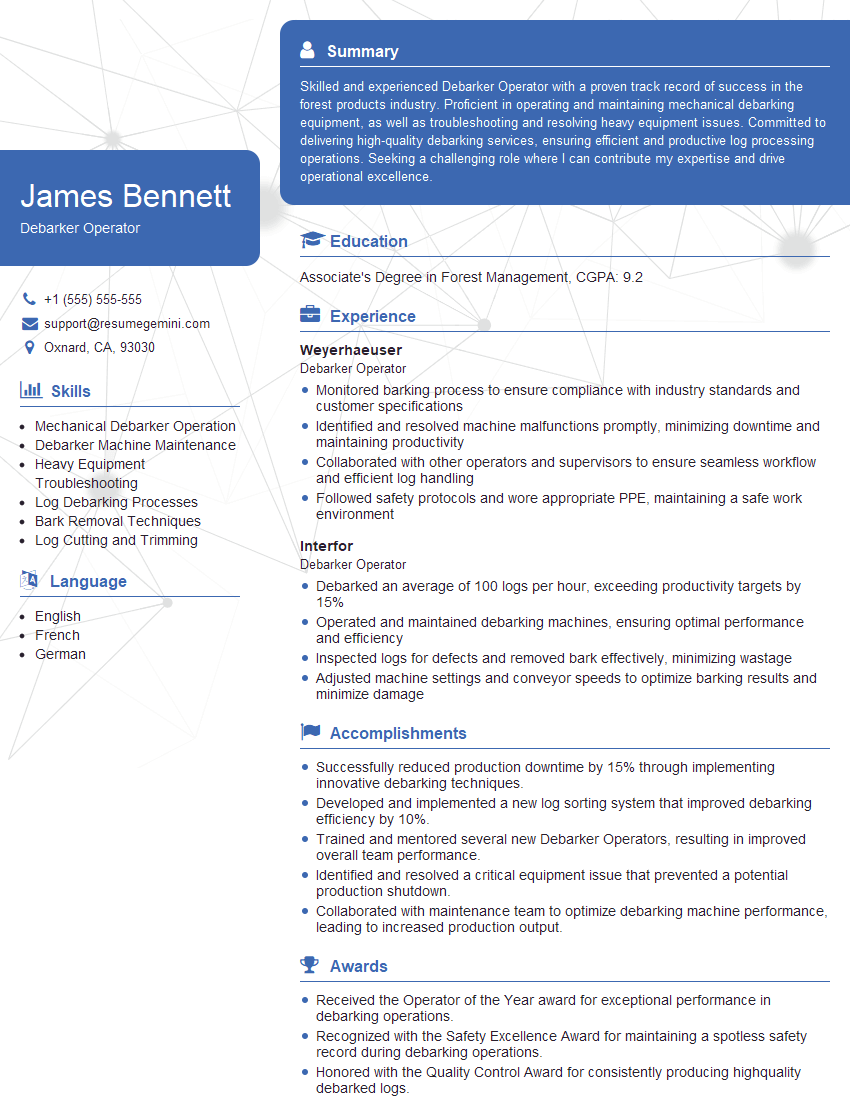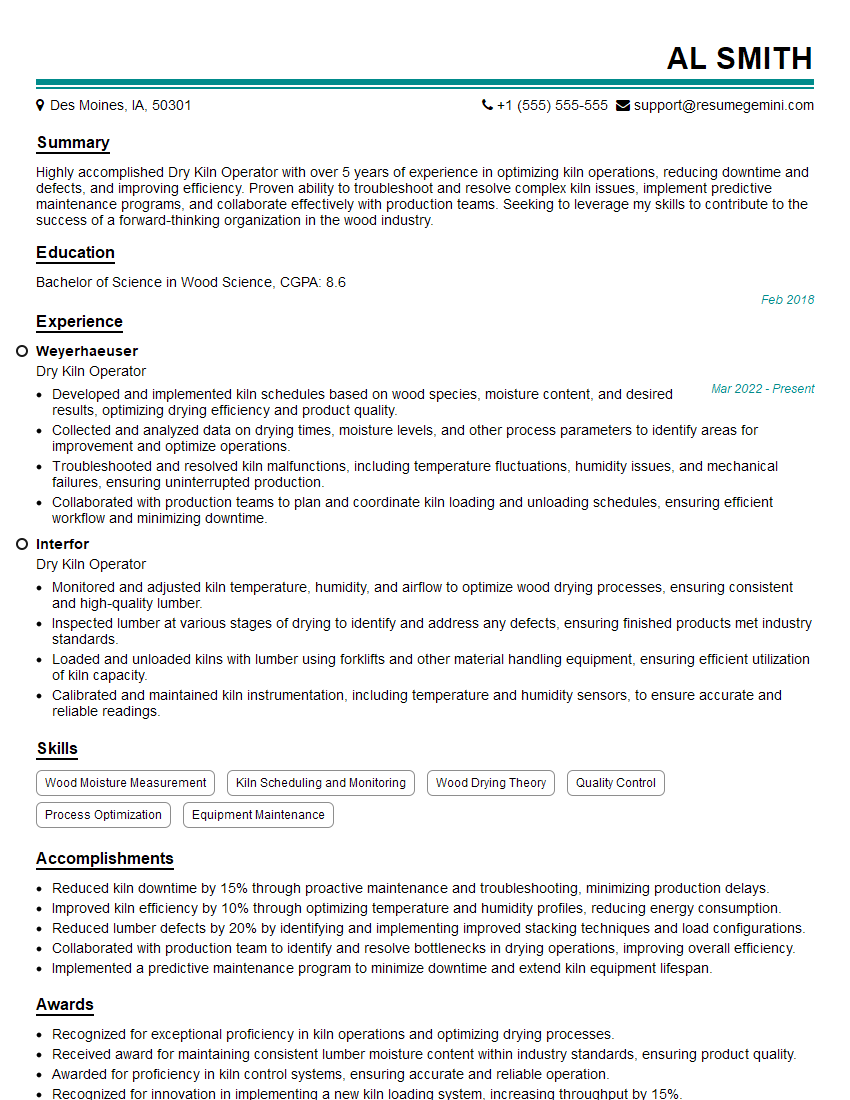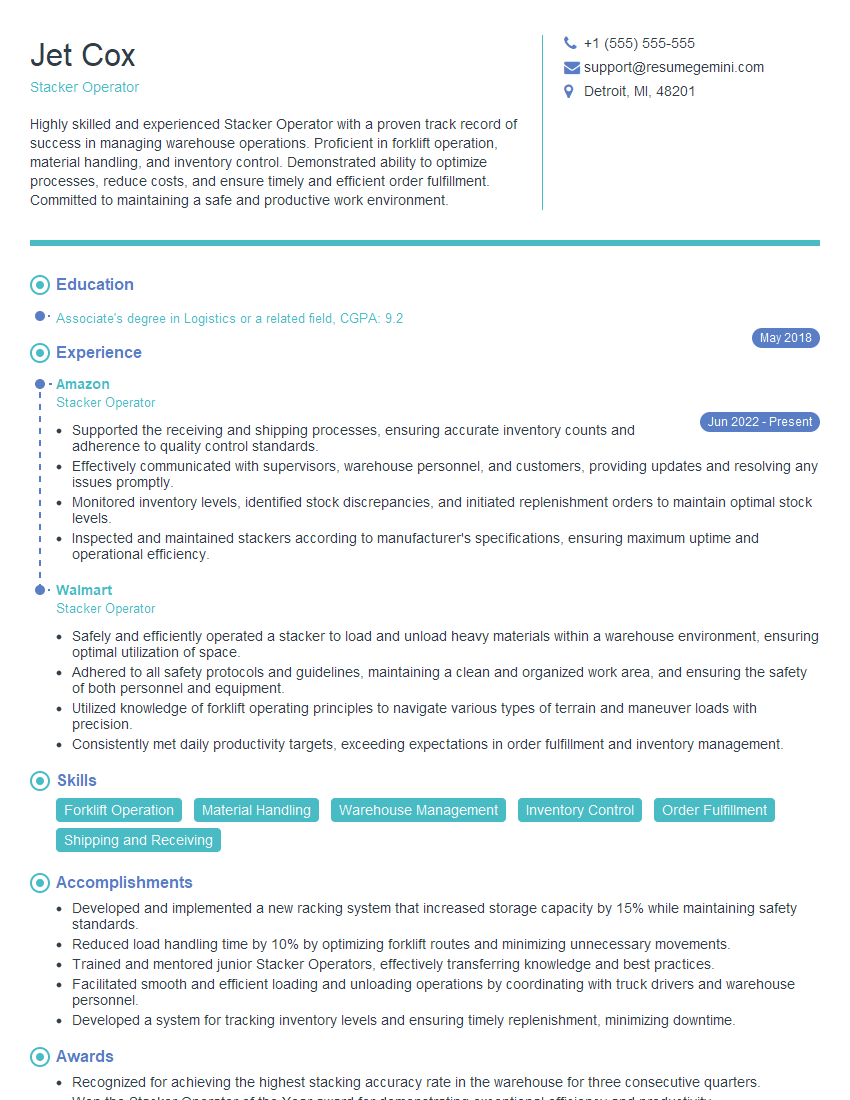Every successful interview starts with knowing what to expect. In this blog, we’ll take you through the top Lumber Processing Equipment Operation interview questions, breaking them down with expert tips to help you deliver impactful answers. Step into your next interview fully prepared and ready to succeed.
Questions Asked in Lumber Processing Equipment Operation Interview
Q 1. Describe your experience operating a sawmill headrig.
My experience operating sawmill headrigs spans over 10 years, encompassing various models from different manufacturers. I’m proficient in both manual and automated systems. My responsibilities included setting up the headrig for different log sizes and species, optimizing cutting patterns for maximum yield and minimizing waste, and maintaining the saw’s alignment and sharpness. For example, I once worked on a challenging project where we were processing unusually knotty pine logs. By carefully adjusting the headrig settings and employing a specific sawing technique, I was able to significantly reduce the amount of lumber downgraded due to knot damage, improving the overall yield and profitability of the operation.
I’m adept at troubleshooting common issues, such as saw blade deflection, vibration, and binding, ensuring consistent cutting performance and minimal downtime. Regular preventative maintenance is key, and I’m meticulous about checking saw alignment, lubrication, and the overall condition of the machine after every shift.
Q 2. Explain the process of debarking logs.
Debarking is the crucial initial step in lumber processing, removing the bark from logs before they enter the sawmill. This is essential for several reasons: it protects the saw blades from damage, improves lumber quality by removing dirt and contaminants, and increases the efficiency of subsequent processing steps. There are several methods of debarking, including:
- Drum Debarkers: Logs are rotated within a drum lined with rotating debarking tools. This is effective for a wide range of log sizes and species.
- Ring Debarkers: Logs are fed through a ring of debarking tools that rotate against them. This method is efficient for larger logs.
- Hydraulic Debarkers: These use hydraulically powered arms to remove bark. They are often preferred for more delicate logs.
The choice of debarker depends on factors such as log size, species, and processing capacity. Proper maintenance of the debarker, including regular sharpening of the tools and cleaning of the machine, is vital to ensuring efficient and effective bark removal.
Q 3. What are the common causes of saw blade malfunctions?
Saw blade malfunctions are a common issue in sawmill operations, often resulting in downtime and reduced lumber quality. The most frequent causes include:
- Dull or Damaged Teeth: This is the most common cause, leading to poor cutting performance and increased friction. Regular sharpening and inspection are essential.
- Improper Tension: Insufficient tension can cause blade deflection or breakage, while excessive tension can lead to premature wear.
- Misalignment: Even slight misalignment can lead to uneven cuts, binding, and increased vibration.
- Overheating: Excessive friction or improper lubrication can overheat the blade, leading to warping or damage.
- Poor Quality Blades: Using low-quality blades can significantly shorten their lifespan and increase the frequency of malfunctions.
Preventative maintenance, proper blade handling, and regular inspections are crucial to minimizing saw blade malfunctions and ensuring consistent, efficient cutting.
Q 4. How do you ensure the quality of lumber during the drying process?
Maintaining lumber quality during drying is critical to prevent defects and maximize value. This involves careful control of several factors:
- Temperature and Humidity: Precise control of these factors is essential to prevent cracking, warping, and checking. The drying schedule should be tailored to the wood species and size.
- Air Circulation: Adequate air circulation ensures even drying and prevents pockets of moisture that can lead to defects.
- Stacking and Spacing: Proper stacking and spacing prevent uneven drying and allow for optimal air circulation.
- Monitoring: Regular monitoring of temperature, humidity, and moisture content is crucial to adjust the drying process as needed.
Modern kilns often employ sophisticated control systems that automate these processes, but careful monitoring and adjustments are still necessary to achieve optimal results. For example, we sometimes use different drying schedules for heartwood and sapwood to prevent cracking in faster-drying sapwood.
Q 5. What safety procedures do you follow when operating lumber processing equipment?
Safety is paramount in lumber processing. My safety procedures include:
- Personal Protective Equipment (PPE): Consistent use of safety glasses, hearing protection, steel-toed boots, and appropriate clothing is non-negotiable.
- Machine Guards: Ensuring all machine guards are in place and functioning correctly before operating any equipment.
- Lockout/Tagout Procedures: Following strict lockout/tagout procedures when performing maintenance or repairs on equipment.
- Regular Inspections: Conducting regular inspections of equipment for any signs of wear or damage.
- Emergency Procedures: Being familiar with emergency procedures, including the location of fire extinguishers and first-aid stations, and knowing how to react in case of an accident.
- Training: Maintaining up-to-date training on safe operating procedures for all equipment used.
Furthermore, I always prioritize a clean and organized work environment to reduce the risk of accidents. A culture of safety is crucial in a lumber mill, and active participation in safety meetings and training sessions is essential.
Q 6. Explain your experience with different types of planers.
My experience encompasses various types of planers, including:
- Surface Planers: Used to smooth and flatten the surface of lumber. I’m experienced in adjusting the planer knives for different thicknesses and feed rates.
- Thickness Planers: Used to plane lumber to a precise thickness. Accurate setup and maintenance are critical to ensure consistency.
- Four-Sided Planers: These machines plane all four sides of the lumber simultaneously. They require precise adjustments and careful monitoring to avoid damage.
I understand the nuances of each type of planer, including adjusting the knives, maintaining proper feed rates, and troubleshooting common issues such as chatter, snipe, and uneven planing. For example, when working with harder woods, I adjust the feed rate to prevent excessive wear on the knives and maintain a smooth finish.
Q 7. How do you troubleshoot a malfunctioning edger?
Troubleshooting a malfunctioning edger involves a systematic approach. First, I would identify the specific problem: is it an issue with the saw blades, the feed mechanism, the alignment, or the controls? Once the problem is identified, I would proceed as follows:
- Inspect the Saw Blades: Check for dull or damaged blades, improper tension, or misalignment.
- Check the Feed Mechanism: Ensure the log feed is operating smoothly and consistently. Look for any blockages or mechanical issues.
- Verify Alignment: Check the alignment of the saws, ensuring they are parallel and properly spaced.
- Examine the Controls: Verify that all electrical and hydraulic components are functioning correctly.
- Consult Maintenance Manuals: Refer to the edger’s maintenance manual for specific troubleshooting guidance.
In many cases, a simple adjustment, such as blade sharpening or realignment, can resolve the problem. However, more complex issues might require specialized tools or the assistance of a qualified technician. For example, I once resolved an edger malfunction by identifying a loose bolt in the feed mechanism, a relatively simple fix that prevented significant downtime.
Q 8. Describe your experience with lumber grading.
Lumber grading is a crucial process in the sawmill industry, determining the quality and value of each piece of lumber. It involves visually inspecting boards for defects such as knots, checks, splits, and decay, and classifying them according to established grading rules. These rules vary depending on the lumber species and intended use. For example, a board intended for structural purposes will have stricter grading standards than one used for less demanding applications like pallets. My experience spans over 15 years, working with various species including pine, fir, and hardwood. I’m proficient in both visual grading and the use of automated grading systems that utilize image recognition technology to speed up the process and improve consistency.
I’ve personally overseen the implementation of a new grading system at a previous mill, which resulted in a 10% increase in the yield of high-grade lumber by identifying and utilizing previously overlooked pieces. The key to effective grading is a keen eye for detail, a thorough understanding of the grading rules, and the ability to accurately assess the structural integrity of the lumber.
Q 9. What are the different types of lumber sorting systems?
Lumber sorting systems are critical for efficient sawmill operations. They separate lumber based on grade, size, and species. Several types exist, each with its own advantages and disadvantages:
- Manual Sorting: This traditional method relies on human graders to visually inspect and sort the lumber. While it allows for detailed assessment, it’s slower and prone to human error.
- Automated Sorting Systems: These systems employ scanners and sensors to identify lumber characteristics and automatically direct it to the appropriate sorting location. This increases speed and consistency but requires significant upfront investment.
- Optical Sorting Systems: These advanced systems use high-resolution cameras and image recognition software to identify defects and grade lumber with high accuracy. They are particularly efficient for high-volume sawmills.
- Automated Stacking Systems: These systems automatically stack sorted lumber, increasing efficiency and reducing labor costs. They can also be integrated with other automated systems for a fully integrated solution.
The choice of system depends on factors like mill size, budget, lumber species, and desired level of automation. I’ve worked with all of these systems, and the transition from manual to automated systems is often a significant upgrade in terms of efficiency and productivity.
Q 10. How do you maintain optimal production efficiency in a sawmill?
Maintaining optimal production efficiency in a sawmill is a multifaceted challenge requiring continuous monitoring and optimization. It involves several key strategies:
- Preventative Maintenance: Regular maintenance of all equipment minimizes downtime and ensures smooth operation. (Detailed in the following answer)
- Log Supply Management: Ensuring a consistent supply of logs with appropriate size and quality reduces bottlenecks. This includes optimizing log storage and yard management.
- Optimized Cutting Patterns: Using software to plan cutting patterns that maximize lumber yield from each log significantly impacts output.
- Efficient Labor Management: Properly training and deploying personnel, ensuring effective communication, and optimizing workflows are crucial.
- Real-time Monitoring and Data Analysis: Tracking key performance indicators (KPIs) such as downtime, lumber yield, and production rates allows for identifying areas for improvement.
For instance, at one mill, we implemented a new log sorting system and optimized cutting patterns, resulting in a 15% increase in lumber production within six months.
Q 11. Explain your experience with preventative maintenance on lumber processing equipment.
Preventative maintenance (PM) is the cornerstone of maintaining efficient lumber processing equipment. My approach involves a detailed PM schedule for each machine, including regular inspections, lubrication, and replacement of worn parts. This schedule is tailored to the specific equipment and its operating conditions. For example, chainsaws and debarkers require frequent lubrication and sharpening, whereas edgers and planers require regular checks for blade alignment and wear.
I utilize a computerized maintenance management system (CMMS) to track PM activities, schedule maintenance tasks, and manage spare parts inventory. This ensures that all scheduled maintenance tasks are completed on time and that we have the necessary parts readily available. Furthermore, I emphasize the importance of operator training to ensure proper equipment usage and the early identification of potential problems. A well-trained operator can often spot minor issues before they escalate into major breakdowns.
Q 12. What are the common maintenance issues with dry kilns?
Dry kilns are essential for drying lumber to the desired moisture content. Common maintenance issues include:
- Heating System Problems: Malfunctions in the burners, heating coils, or steam generation systems can lead to uneven drying and increased energy consumption.
- Ventilation Issues: Problems with fans, dampers, or air circulation can compromise the drying process and lead to mold or degrade in lumber.
- Sensor Malfunctions: Faulty temperature and humidity sensors can result in inaccurate drying conditions and potentially damage the lumber.
- Structural Issues: Leaks, cracks in the kiln walls, and door sealing problems can lead to energy loss and inconsistent drying.
- Control System Issues: Software glitches or problems with the kiln’s control system can affect the entire drying process.
Regular inspections, preventative maintenance, and prompt repairs are crucial to prevent these issues and ensure the consistent operation of dry kilns. I emphasize the importance of routine cleaning and calibration to ensure optimal performance.
Q 13. How do you handle log jams in a sawmill?
Log jams are a serious problem in sawmills, causing significant downtime and potential damage to equipment. My approach to handling log jams involves a combination of prevention and swift response:
- Prevention: Regular inspection of the log handling system, proper log sorting, and maintenance of equipment (particularly the infeed system) minimizes the risk of jams.
- Response: If a jam occurs, the first step is to shut down the affected equipment to prevent further damage. We then assess the situation, determining the cause and severity of the jam. Minor jams can often be cleared manually, while more significant jams may require the use of specialized equipment such as a grapple or crane.
- Root Cause Analysis: Following a jam, a thorough investigation is conducted to determine the underlying cause. This may involve checking for blockages, damaged equipment, or inefficiencies in the log handling process. Necessary steps are taken to prevent recurrence.
I’ve developed a structured procedure for handling log jams, which includes clear communication protocols and roles for the team involved in resolving the issue. This minimizes downtime and prevents further damage.
Q 14. Describe your experience with different types of log handling equipment.
I have extensive experience with a variety of log handling equipment, crucial for efficient sawmill operations. These include:
- Log Decks and Stackers: These are used for storing and sorting logs before processing. I’ve worked with both manual and automated systems.
- Log Grapples and Cranes: Used for handling and moving logs within the sawmill yard. My experience includes hydraulic and cable-operated systems.
- Log Conveyors: These transport logs from the yard to the processing area. I’m familiar with different types of conveyors, including chain conveyors, roller conveyors, and hydraulic log turners.
- Debarkers: These remove bark from logs before sawing. I’ve worked with both drum and ring debarkers.
Understanding the capabilities and limitations of each type of equipment, as well as their maintenance requirements, is essential for optimizing log handling and ensuring safety. In one instance, I spearheaded the upgrade of our log handling system, implementing an automated system that reduced log handling time by 20% and improved worker safety.
Q 15. What are the environmental considerations in lumber processing?
Environmental considerations in lumber processing are paramount, focusing on minimizing waste and pollution throughout the entire process. This includes responsible forest management, efficient use of resources, and waste reduction strategies.
- Sustainable Forestry: Sourcing lumber from responsibly managed forests, certified by organizations like the Forest Stewardship Council (FSC), ensures sustainable harvesting practices and prevents deforestation.
- Waste Reduction: Optimizing cutting patterns (as discussed later) minimizes scrap wood. Sawdust and woodchips can be repurposed as biomass fuel, reducing reliance on fossil fuels.
- Water Management: Many lumber processing operations use water for cleaning and cooling. Implementing water recycling systems and minimizing water usage is crucial to conserving this vital resource.
- Air Quality: Sawmills generate dust and particulate matter. Implementing dust collection systems and employing proper ventilation significantly reduces air pollution and protects worker health.
- Wastewater Treatment: Proper treatment of wastewater generated during lumber processing is vital to prevent environmental contamination. This often involves settling ponds or more advanced treatment systems.
For example, in a mill I worked at, we implemented a closed-loop water system, recycling nearly 80% of the water used in the cleaning process. This significantly reduced our water consumption and discharge.
Career Expert Tips:
- Ace those interviews! Prepare effectively by reviewing the Top 50 Most Common Interview Questions on ResumeGemini.
- Navigate your job search with confidence! Explore a wide range of Career Tips on ResumeGemini. Learn about common challenges and recommendations to overcome them.
- Craft the perfect resume! Master the Art of Resume Writing with ResumeGemini’s guide. Showcase your unique qualifications and achievements effectively.
- Don’t miss out on holiday savings! Build your dream resume with ResumeGemini’s ATS optimized templates.
Q 16. How do you ensure the safe operation of conveyor systems?
Ensuring the safe operation of conveyor systems is critical for preventing accidents and maintaining productivity. This involves a multi-faceted approach incorporating regular maintenance, safety protocols, and operator training.
- Regular Inspections: Daily inspections of conveyor belts, rollers, and drive mechanisms check for wear and tear, misalignment, or loose components. This prevents breakdowns and potential hazards.
- Emergency Stops: Easily accessible emergency stop buttons should be strategically placed along the conveyor system, allowing for immediate shutdown in case of emergencies.
- Guards and Enclosures: Moving parts of the conveyor system should be properly guarded to prevent accidental contact. Enclosures prevent materials from being ejected and causing injury.
- Lockout/Tagout Procedures: Before performing maintenance or repairs on any part of the conveyor system, proper lockout/tagout procedures must be followed to prevent accidental startup.
- Operator Training: Thorough training is essential for conveyor system operators, covering safe operating procedures, emergency response, and recognizing potential hazards.
Think of it like driving a car – regular maintenance (inspections), clear rules (protocols), and knowing how to react in an emergency (training) are all vital for safe operation.
Q 17. What is your experience with lumber stacking and storage?
My experience with lumber stacking and storage is extensive, encompassing various techniques and considerations to maintain lumber quality and prevent damage.
- Proper Stacking Techniques: Lumber should be stacked with appropriate spacing to allow for air circulation and prevent warping or staining. Using stackers and lift trucks ensures even distribution of weight.
- Moisture Control: Controlling the moisture content of the lumber during storage is crucial. Proper ventilation and covering can help regulate humidity and prevent mold or mildew growth.
- Protection from the Elements: Lumber should be protected from direct sunlight, rain, and snow to prevent damage and maintain quality. Covering the stacks with tarps or storing them in covered areas is recommended.
- Organization and Identification: Clear labeling and organization of lumber stacks according to species, grade, and dimensions makes inventory management efficient and reduces errors. Barcoding systems can improve accuracy.
- First-In, First-Out (FIFO): Implementing a FIFO system ensures that older lumber is used first, preventing excessive storage time and potential quality degradation.
In my previous role, we implemented a new stacking system that reduced lumber damage by 15% by optimizing air circulation and protecting stacks from the elements.
Q 18. Explain your experience with different types of saws (band saws, circular saws, etc.)
I have extensive experience operating and maintaining various types of saws used in lumber processing, each with its own advantages and applications.
- Band Saws: These saws are known for their smooth cuts and ability to handle curves. They are ideal for intricate cuts and smaller operations. Regular blade tension and alignment are crucial for optimal performance and safety.
- Circular Saws: These saws are highly efficient for high-volume production, particularly for straight cuts. They require proper blade selection based on the wood type and desired cut quality. Safety measures like riving knives and blade guards are essential.
- Gang Saws: These are used for high-speed production of multiple boards simultaneously from a single log. Precise alignment of saw blades is critical for accurate cutting and preventing damage.
- Chainsaws: Used primarily for bucking logs into manageable lengths in the initial stages of processing. Proper safety precautions, including personal protective equipment (PPE), are essential.
For example, in one project, we switched from using primarily circular saws to a more efficient gang saw system, leading to a 20% increase in production while maintaining cut accuracy.
Q 19. Describe your experience with optimizing cutting patterns for minimal waste.
Optimizing cutting patterns to minimize waste is a crucial aspect of efficient lumber processing. This involves carefully planning the cuts to maximize the usable lumber from each log or board.
- Computerized Optimizers: Modern sawmills use sophisticated software programs that analyze log dimensions and generate cutting patterns to minimize waste. These programs consider factors such as log shape, defects, and desired board sizes.
- Manual Optimization: Even without sophisticated software, experienced operators can develop efficient cutting patterns based on their understanding of log characteristics and board demands.
- Waste Recycling: Even with optimal cutting patterns, some waste is inevitable. Repurposing scraps for smaller products, biomass fuel, or mulch reduces environmental impact.
- Grade Optimization: Matching the cutting patterns to the desired lumber grade ensures that high-value wood is used effectively and lower-grade material is utilized appropriately.
In a previous role, by implementing a new computerized optimization system, we were able to reduce waste by 10%, leading to substantial cost savings and improved profitability.
Q 20. How do you ensure the accuracy of lumber dimensions?
Ensuring the accuracy of lumber dimensions is critical for meeting customer specifications and maintaining quality. Several methods contribute to dimensional accuracy.
- Precise Sawing Equipment: Well-maintained and calibrated saws, along with proper blade selection, are fundamental to accurate cutting.
- Regular Calibration and Maintenance: Regular calibration and maintenance of all measuring devices, including length gauges and thicknessers, is essential for maintaining accuracy.
- Quality Control Checks: Implementing robust quality control checks throughout the process, including random sampling and measurement verification, ensures dimensional consistency.
- Automated Measurement Systems: Modern lumber processing systems often include automated measurement systems that provide real-time feedback and adjust cutting parameters as needed to ensure accurate dimensions.
For instance, we implemented a system of regular calibration checks on our planers and thicknessers, which drastically reduced discrepancies in final board thickness, leading to less rejected lumber.
Q 21. What is your experience with using computerized lumber processing systems?
I have significant experience with computerized lumber processing systems, including optimization software, automated control systems, and data management software.
- Optimization Software: I’m proficient in using various optimization software packages to generate efficient cutting patterns, minimizing waste and maximizing yield. This includes optimizing for different lumber grades and sizes.
- Automated Control Systems: Experience with Programmable Logic Controllers (PLCs) and Human-Machine Interfaces (HMIs) allows for efficient control and monitoring of automated equipment like saws, conveyors, and stackers. This improves productivity and reduces manual intervention.
- Data Management Systems: Proficient in using various data management systems to track lumber inventory, production data, and quality control metrics. This provides insights for optimizing processes and improving efficiency.
- Troubleshooting and Maintenance: Experience in troubleshooting and maintaining computerized systems, including diagnosing and resolving software and hardware issues, is crucial for minimizing downtime.
For example, I once successfully integrated a new computerized system into an existing sawmill, resulting in a 15% increase in productivity and a 5% reduction in production costs within six months.
Q 22. Explain your understanding of lumber species and their properties.
Understanding lumber species and their properties is fundamental to efficient lumber processing. Different species possess unique characteristics impacting their workability, durability, and final product quality. For example, hardwoods like oak and maple are known for their strength and density, making them ideal for furniture and flooring. However, their hardness also makes them more challenging to process, requiring more powerful equipment and potentially specialized tooling. Softwoods like pine and fir are generally easier to work with, offering a good balance of strength and machinability, often used in construction. Key properties to consider include:
- Density: Affects strength, weight, and ease of processing.
- Hardness: Influences tool wear and the required cutting force.
- Grain structure: Impacts the appearance, strength, and susceptibility to splitting.
- Moisture content: Critically impacts dimensional stability and susceptibility to warping and cracking; proper drying is crucial.
- Durability: Resistance to decay, insect infestation, and weathering varies greatly between species.
Understanding these properties allows for optimization of processing techniques, selection of appropriate tools, and prediction of final product performance. For instance, knowing a species is prone to splitting allows preemptive measures to be taken during sawing and further processing.
Q 23. How do you identify and address lumber defects?
Identifying and addressing lumber defects is crucial for producing high-quality lumber. These defects can significantly impact the strength, appearance, and value of the final product. I use a combination of visual inspection and sometimes specialized tools to detect defects. Common defects include:
- Knots: Concentrations of denser wood where branches were attached; their size, type, and position affect strength and value.
- Checks: Small cracks that extend radially in the wood, often due to drying stresses.
- Splits: Larger cracks that can run along the grain or across it; often caused by drying, mechanical stress, or insect damage.
- Wane: Presence of bark or lack of wood at the edge of a board.
- Decay: Deterioration of wood caused by fungi.
Addressing defects involves various strategies depending on the severity and type of defect. Small knots might be acceptable, while large or loose knots might necessitate trimming or downgrading the lumber. Splits can be repaired with wood filler or the affected piece discarded. Wane is often trimmed off. Severely decayed lumber is typically rejected.
Q 24. What are your experience with different types of wood chippers?
My experience encompasses various wood chipper types, each with its own advantages and applications. I’ve worked extensively with:
- Drum chippers: These are excellent for processing large volumes of wood, producing consistent chip size, and handling a wide range of material sizes, often used in large-scale operations.
- Disc chippers: Known for their ability to handle knotty and difficult-to-chip wood, making them suitable for processing sawmill residues. However, they might produce less uniform chip size than drum chippers.
- Hammermill chippers: These are capable of processing various wood waste streams, including branches and green wood. They excel in creating smaller, more uniformly sized chips.
The choice of chipper depends on factors such as the type and volume of material being processed, the desired chip size, and the required production capacity. For instance, a large sawmill might utilize a drum chipper for efficient processing of large volumes of wood residue, while a smaller operation might opt for a disc chipper for its versatility.
Q 25. How do you maintain the sharpness and condition of saw blades?
Maintaining saw blade sharpness is critical for efficient cutting, minimizing kerf (width of the cut), extending blade life, and producing high-quality lumber. This involves regular sharpening and proper handling. Procedures include:
- Regular sharpening: Using specialized sharpening equipment to maintain the correct tooth profile and geometry. The frequency of sharpening depends on the type of wood being processed and the intensity of use.
- Inspection for damage: Checking for chipped, broken, or worn teeth. Damaged teeth should be repaired or replaced immediately.
- Proper tensioning: Maintaining the correct tension on the saw blade to prevent bending or warping during operation.
- Correct alignment: Ensuring the saw blade is properly aligned with the arbor and guide to prevent vibrations and premature wear.
- Lubrication: Utilizing appropriate lubricants on bearings and other moving parts to reduce friction and extend the life of the equipment.
Ignoring blade maintenance can lead to dull blades, increased power consumption, reduced productivity, and a poor surface finish on lumber. A well-maintained saw blade is an investment in efficiency and safety.
Q 26. Describe your troubleshooting skills related to hydraulic systems in lumber processing equipment.
Troubleshooting hydraulic systems requires a systematic approach. My experience involves diagnosing problems by:
- Visual inspection: Checking for leaks, loose connections, and damaged hoses.
- Pressure testing: Verifying that hydraulic pressure is within the specified range.
- Flow rate measurement: Assessing whether the hydraulic fluid is flowing at the correct rate.
- Component testing: Checking individual components like pumps, valves, and cylinders for proper operation.
- Testing using pressure gauges and flow meters: Accurately pinpoint issues within the system and avoid further damage.
For example, if a hydraulic cylinder fails to extend, I would systematically check the hydraulic lines for blockages, inspect the cylinder for damage, and test the hydraulic valve controlling the cylinder’s operation. I’m familiar with various troubleshooting methods, such as pressure drop analysis, to determine the precise source of a hydraulic issue. Knowing the hydraulic schematic of the machinery is key.
Q 27. How do you handle emergency situations in a lumber processing facility?
Emergency situations in a lumber processing facility can range from equipment malfunctions to injuries. My approach involves:
- Immediate action: Addressing the immediate threat, such as shutting down equipment or providing first aid.
- Safety protocols: Following established emergency procedures, including evacuation if necessary.
- Communication: Notifying emergency services and management personnel.
- Assessment: Evaluating the extent of the damage and identifying the cause of the incident.
- Documentation: Thoroughly documenting the event for investigation and future preventative measures.
For example, if a saw blade breaks, I’d immediately shut down the machine, secure the area, and report the incident. Following company procedures, I’d work with maintenance to replace the blade, ensuring all safety protocols are followed before restarting the process.
Q 28. What are the key performance indicators (KPIs) you monitor in lumber processing?
Key performance indicators (KPIs) in lumber processing are crucial for monitoring efficiency, productivity, and cost-effectiveness. I regularly monitor:
- Production output: Board feet or cubic meters of lumber produced per hour or shift.
- Downtime: Percentage of time the equipment is not operational due to maintenance, repairs, or other causes.
- Yield: Ratio of usable lumber produced to the total volume of logs processed.
- Waste: Percentage of raw material lost due to defects or inefficient processing.
- Energy consumption: Amount of energy used per unit of lumber produced.
- Maintenance costs: Expenses associated with equipment maintenance and repairs.
By tracking these KPIs, I can identify areas for improvement, optimize processes, and ensure the facility operates efficiently and profitably. Regular analysis of these metrics helps in making data-driven decisions for optimizing resource utilization and improving overall productivity. This often leads to process improvements and identification of potential issues early on.
Key Topics to Learn for Lumber Processing Equipment Operation Interview
- Safety Procedures and Regulations: Understanding and adhering to all relevant safety protocols for operating lumber processing equipment, including lockout/tagout procedures and personal protective equipment (PPE) requirements.
- Equipment Operation and Maintenance: Hands-on knowledge of operating various lumber processing machines (e.g., saws, planers, graders). This includes understanding preventative maintenance schedules and troubleshooting common malfunctions.
- Wood Properties and Grades: Familiarity with different types of wood, their properties, and grading standards. This is crucial for efficient processing and minimizing waste.
- Production Processes and Optimization: Understanding the entire lumber processing workflow, from log intake to finished product. Knowing how to optimize processes for efficiency and quality control.
- Quality Control and Inspection: Identifying defects in lumber and applying appropriate quality control measures throughout the processing stages. This includes understanding grading rules and standards.
- Problem-Solving and Troubleshooting: Demonstrating the ability to identify and resolve equipment malfunctions, production bottlenecks, and quality issues effectively and safely.
- Data Interpretation and Record Keeping: Understanding and utilizing production data to track efficiency, identify areas for improvement, and maintain accurate records.
- Teamwork and Communication: Highlighting your ability to collaborate effectively with team members, communicate clearly, and follow instructions.
Next Steps
Mastering Lumber Processing Equipment Operation opens doors to a rewarding career with excellent growth potential, offering opportunities for specialization, increased responsibility, and higher earning potential. To significantly enhance your job prospects, creating an ATS-friendly resume is crucial. This ensures your application is effectively scanned and considered by hiring managers. ResumeGemini is a trusted resource to help you build a professional and impactful resume. We provide examples of resumes tailored specifically to Lumber Processing Equipment Operation to guide you in crafting a compelling application. Take the next step towards your dream career today!
Explore more articles
Users Rating of Our Blogs
Share Your Experience
We value your feedback! Please rate our content and share your thoughts (optional).
What Readers Say About Our Blog
Hello,
We found issues with your domain’s email setup that may be sending your messages to spam or blocking them completely. InboxShield Mini shows you how to fix it in minutes — no tech skills required.
Scan your domain now for details: https://inboxshield-mini.com/
— Adam @ InboxShield Mini
Reply STOP to unsubscribe
Hi, are you owner of interviewgemini.com? What if I told you I could help you find extra time in your schedule, reconnect with leads you didn’t even realize you missed, and bring in more “I want to work with you” conversations, without increasing your ad spend or hiring a full-time employee?
All with a flexible, budget-friendly service that could easily pay for itself. Sounds good?
Would it be nice to jump on a quick 10-minute call so I can show you exactly how we make this work?
Best,
Hapei
Marketing Director
Hey, I know you’re the owner of interviewgemini.com. I’ll be quick.
Fundraising for your business is tough and time-consuming. We make it easier by guaranteeing two private investor meetings each month, for six months. No demos, no pitch events – just direct introductions to active investors matched to your startup.
If youR17;re raising, this could help you build real momentum. Want me to send more info?
Hi, I represent an SEO company that specialises in getting you AI citations and higher rankings on Google. I’d like to offer you a 100% free SEO audit for your website. Would you be interested?
Hi, I represent an SEO company that specialises in getting you AI citations and higher rankings on Google. I’d like to offer you a 100% free SEO audit for your website. Would you be interested?
good
